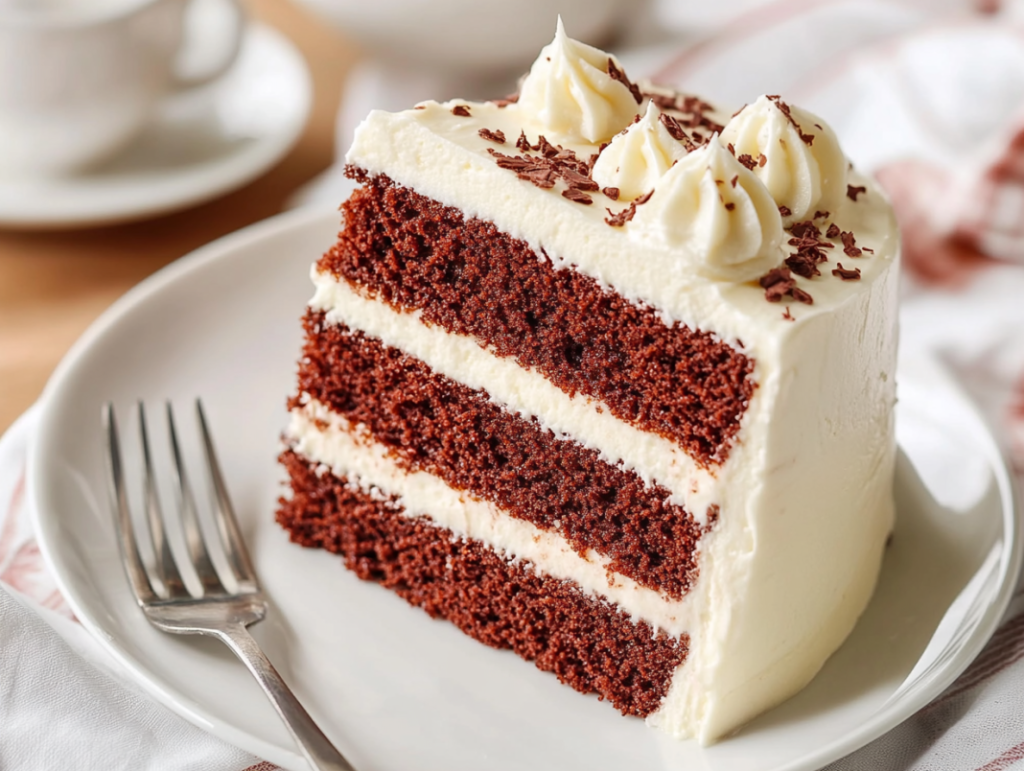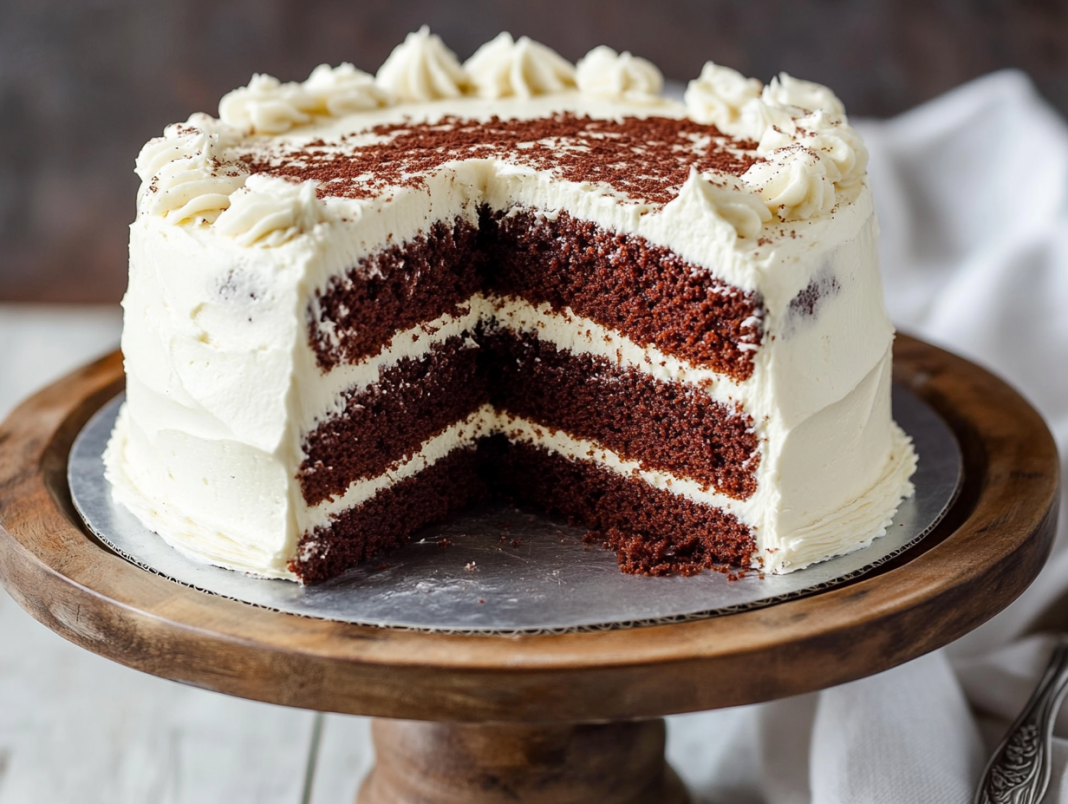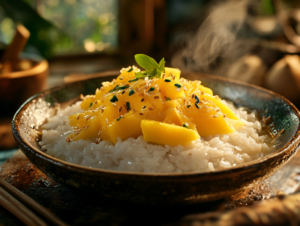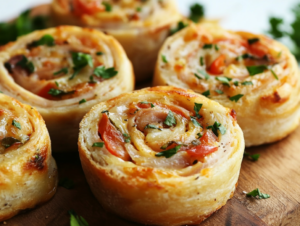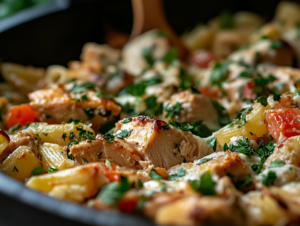In the realm of classic desserts, few cakes boast a history as rich and intriguing as the Mahogany Cake. Often regarded as the precursor to the modern red velvet cake, this confection offers a delicate balance of mild chocolate flavor and a tender, velvety crumb. Its subtle reddish-brown hue, reminiscent of polished mahogany wood, lends the cake its distinctive name. Recently, Mahogany Cake has experienced a resurgence in popularity, captivating both seasoned bakers and newcomers alike.
A Glimpse into History
Mahogany Cake dates back to the late 1800s, marking its place as one of America’s earliest chocolate cakes. During this era, bakers discovered that combining natural cocoa powder with acidic ingredients like buttermilk or vinegar resulted in a cake with a fine, soft crumb and a subtle reddish tint. This natural coloration occurred due to the reaction between the cocoa’s anthocyanins and the acidic components, long before the advent of modern food colorings.
The Unique Characteristics of Mahogany Cake
What sets Mahogany Cake apart from its successors is its understated elegance. Unlike the vibrant red velvet cakes of today, which often rely on food coloring for their hue, Mahogany Cake achieves its color naturally through the chemical interplay of its ingredients. The cake’s flavor profile is a harmonious blend of mild chocolate notes, offering a less intense experience than more decadent chocolate cakes. This makes it an ideal choice for those who appreciate subtlety in their desserts.
The Traditional Pairing: Ermine Frosting
Traditionally, Mahogany Cake is adorned with ermine frosting, also known as boiled milk frosting. This classic accompaniment is crafted by cooking a mixture of milk and flour until thickened, then whipping it with butter and sugar to achieve a light, creamy consistency. The result is a frosting that’s less sweet than conventional buttercreams, allowing the delicate flavors of the cake to shine through. Its silky texture complements the tender crumb of the Mahogany Cake perfectly.
Mahogany Cake Recipe
Ingredients
For the Cake:
-
2 cups cake flour
-
3 tablespoons unsweetened cocoa powder
-
1 teaspoon baking soda
-
3/4 teaspoon table salt
-
1/2 cup unsalted butter, softened
-
1 1/3 cups granulated sugar
-
1/4 cup canola oil
-
1 teaspoon vanilla extract
-
2 large eggs, at room temperature
-
1 1/4 cups whole buttermilk, at room temperature
For the Ermine Frosting:
-
1 1/2 cups granulated sugar
-
6 tablespoons all-purpose flour
-
1/2 teaspoon kosher salt
-
1 1/2 cups whole milk
-
3 sticks (12 ounces) unsalted butter, at room temperature
-
1/2 teaspoons vanilla extract
-
1/2 teaspoon almond extract
Directions
-
Prepare the Oven and Pans: Preheat your oven to 350°F (175°C). Grease two 8-inch round cake pans and line the bottoms with parchment paper.
-
Mix Dry Ingredients: In a medium bowl, whisk together the cake flour, cocoa powder, baking soda, and salt.
-
Cream Butter and Sugar: In a large bowl, beat the softened butter until smooth and fluffy. Add the sugar, oil, and vanilla extract, and continue beating until the mixture is creamy.
-
Incorporate Eggs: Add the eggs one at a time, beating well after each addition.
-
Combine Wet and Dry Mixtures: With the mixer on low speed, alternately add the flour mixture and buttermilk to the batter, beginning and ending with the flour mixture. Mix until just combined.
-
Bake the Cakes: Divide the batter evenly between the prepared pans. Bake for 30 to 35 minutes, or until a toothpick inserted into the center comes out clean.
-
Cool the Cakes: Allow the cakes to cool in the pans for 10 minutes, then transfer them to a wire rack to cool completely.
-
Prepare the Ermine Frosting:
-
In a medium saucepan, whisk together the sugar, flour, and salt.
-
Gradually whisk in the milk until smooth.
-
Place the saucepan over medium heat and cook, whisking constantly, until the mixture thickens to a pudding-like consistency.
-
Remove from heat and let the mixture cool completely.
-
In a large bowl, beat the softened butter until light and fluffy.
-
Gradually add the cooled milk mixture to the butter, beating until the frosting is smooth and creamy.
-
Mix in the vanilla and almond extracts.
-
-
Assemble the Cake: Place one cake layer on a serving plate. Spread a portion of the ermine frosting evenly over the top. Place the second cake layer on top and apply the remaining frosting over the top and sides of the cake.
Nutritional Information (continued)
Each slice of Mahogany Cake (based on 12 servings) provides approximately 550 calories, making it a hearty dessert that’s perfect for special occasions rather than everyday indulgence. The cake contains 30 grams of total fat, of which around 18 grams are saturated fats, mainly due to the use of butter and ermine frosting. It also includes 65 grams of carbohydrates, with 40 grams of sugar, making it satisfyingly sweet without being cloying. Protein content sits around 5 grams, and sodium levels hover at 350 milligrams per serving. While this cake isn’t a “light” dessert, its nostalgic charm and wholesome ingredients make it a worthy treat when enjoyed in moderation.
Servings, Prep Time, and Cooking Time
This Mahogany Cake recipe yields 12 generous servings, making it ideal for gatherings, birthday celebrations, or festive holiday dinners. The prep time is approximately 30 minutes, which includes mixing the batter and preparing the frosting base. Cooking time clocks in at around 35 minutes, depending on your oven’s accuracy and the size of your cake pans. The frosting requires an additional 20 minutes to make and cool down, so in total, you’re looking at roughly 1.5 to 2 hours from start to finish, including cooling and assembling the cake. Despite the time investment, the end result is a truly unforgettable dessert experience.
Serving Suggestions: Dress It Up or Keep It Classic
While Mahogany Cake shines on its own with a thick layer of ermine frosting, there are several ways you can elevate it for even greater visual and flavor appeal. For a more elegant presentation, consider topping the cake with shaved dark chocolate, toasted coconut flakes, or even a sprinkle of crushed candied pecans for texture. If you’re serving it during the holiday season, a few cranberries or sugared berries on top can add a pop of color and festive flair. Some bakers enjoy pairing Mahogany Cake with a scoop of vanilla bean ice cream or a drizzle of raspberry coulis to contrast its richness. Regardless of how you serve it, this cake is a guaranteed showstopper on any dessert table.
Storage Tips: Keep It Moist and Fresh
Mahogany Cake stores quite well, especially if you follow a few key tips to maintain its signature moisture and texture. If you have leftovers, wrap the cake tightly in plastic wrap or store it in an airtight container to prevent it from drying out. It can be kept at room temperature for up to two days, but for longer freshness, place it in the refrigerator, where it will stay good for up to five days. Just make sure to allow the cake to come to room temperature before serving to bring back its softness and flavor. You can also freeze Mahogany Cake—either whole or sliced—by wrapping each portion in foil and storing it in a freezer-safe bag. It will keep for up to two months, and thawing overnight in the fridge will prepare it for a next-day indulgence.
Variations: Make It Your Own
One of the wonderful things about Mahogany Cake is its adaptability. While the traditional version is beloved, there are several modern twists you can experiment with. For a richer chocolate flavor, try using Dutch-process cocoa, though this may alter the cake’s natural red hue. Some bakers enjoy incorporating a bit of espresso powder into the batter to deepen the cocoa notes, making it ideal for coffee lovers. You can also switch up the frosting by using cream cheese frosting for a tangy contrast, or chocolate buttercream if you’re looking for something more indulgent.
Those who prefer a dairy-free version can substitute plant-based buttermilk (almond milk plus a bit of lemon juice or vinegar) and vegan butter in both the batter and frosting. Gluten-free flour blends also work well in this recipe, though you’ll want to ensure it’s a 1:1 baking substitute to maintain the correct structure and crumb. Some adventurous bakers even fold in orange zest or spiced cinnamon for a seasonal variation that adds warmth and complexity.
Why Mahogany Cake Is Making a Comeback
There’s something undeniably nostalgic and comforting about Mahogany Cake. In an era where viral TikTok trends and extravagant novelty desserts dominate, this classic cake serves as a delicious reminder of simpler times. It’s a recipe passed down through generations, often appearing in handwritten cookbooks and cherished family recipe boxes. Its revival in popularity is due in part to the growing interest in heritage baking and retro desserts, where people are rediscovering the joys of old-fashioned, made-from-scratch treats.
In 2024, Mahogany Cake was even named the most popular dessert of the year by Southern Living, a testament to its enduring appeal. Food lovers are craving authenticity, and Mahogany Cake delivers it in every bite—with ingredients you can pronounce, techniques that make you feel like a seasoned baker, and a taste that lingers long after the plate is cleared. It’s not just a dessert—it’s a culinary heirloom that connects us to the past while delighting modern palates.
Final Thoughts: A Must-Bake for Every Dessert Lover
Whether you’re a novice baker or a seasoned pastry pro, Mahogany Cake is a rewarding recipe that belongs in your repertoire. Its tender, chocolate-kissed layers and silky-smooth frosting are the epitome of homemade indulgence. Beyond flavor, it carries with it the charm of yesteryear—a story in every crumb. Perfect for birthdays, holidays, Sunday dinners, or just because you feel like baking something special, this cake invites you to slow down, mix with care, and savor every slice.
So dust off your mixing bowls, preheat the oven, and give this timeless classic a try. Mahogany Cake isn’t just back—it’s here to stay.
Print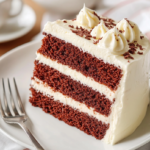
Mahogany Cake: A Timeless Classic Rediscovered
Ingredients
For the Cake:
-
2 cups cake flour
-
3 tablespoons unsweetened cocoa powder
-
1 teaspoon baking soda
-
3/4 teaspoon table salt
-
1/2 cup unsalted butter, softened
-
1 1/3 cups granulated sugar
-
1/4 cup canola oil
-
1 teaspoon vanilla extract
-
2 large eggs, at room temperature
-
1 1/4 cups whole buttermilk, at room temperature
For the Ermine Frosting:
-
1 1/2 cups granulated sugar
-
6 tablespoons all-purpose flour
-
1/2 teaspoon kosher salt
-
1 1/2 cups whole milk
-
3 sticks (12 ounces) unsalted butter, at room temperature
-
1/2 teaspoons vanilla extract
-
1/2 teaspoon almond extract
Instructions
-
Prepare the Oven and Pans: Preheat your oven to 350°F (175°C). Grease two 8-inch round cake pans and line the bottoms with parchment paper.
-
Mix Dry Ingredients: In a medium bowl, whisk together the cake flour, cocoa powder, baking soda, and salt.
-
Cream Butter and Sugar: In a large bowl, beat the softened butter until smooth and fluffy. Add the sugar, oil, and vanilla extract, and continue beating until the mixture is creamy.
-
Incorporate Eggs: Add the eggs one at a time, beating well after each addition.
-
Combine Wet and Dry Mixtures: With the mixer on low speed, alternately add the flour mixture and buttermilk to the batter, beginning and ending with the flour mixture. Mix until just combined.
-
Bake the Cakes: Divide the batter evenly between the prepared pans. Bake for 30 to 35 minutes, or until a toothpick inserted into the center comes out clean.
-
Cool the Cakes: Allow the cakes to cool in the pans for 10 minutes, then transfer them to a wire rack to cool completely.
-
Prepare the Ermine Frosting:
-
In a medium saucepan, whisk together the sugar, flour, and salt.
-
Gradually whisk in the milk until smooth.
-
Place the saucepan over medium heat and cook, whisking constantly, until the mixture thickens to a pudding-like consistency.
-
Remove from heat and let the mixture cool completely.
-
In a large bowl, beat the softened butter until light and fluffy.
-
Gradually add the cooled milk mixture to the butter, beating until the frosting is smooth and creamy.
-
Mix in the vanilla and almond extracts.
-
-
Assemble the Cake: Place one cake layer on a serving plate. Spread a portion of the ermine frosting evenly over the top. Place the second cake layer on top and apply the remaining frosting over the top and sides of the cake.

